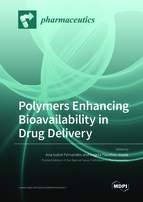Polymers Enhancing Bioavailability in Drug Delivery
A special issue of Pharmaceutics (ISSN 1999-4923). This special issue belongs to the section "Drug Delivery and Controlled Release".
Deadline for manuscript submissions: closed (20 June 2022) | Viewed by 41169
Special Issue Editors
Interests: polymers and polymeric systems; protein delivery; formulation in pediatrics; drug solubility enhancement; 3D-printing of pharmaceuticals
Special Issues, Collections and Topics in MDPI journals
Interests: bacterial cellulose; biomolecules; biopolymer; nanomaterial; industrial microbiology
Special Issues, Collections and Topics in MDPI journals
Special Issue Information
Dear Colleagues,
Currently, many of the drug entities entering the clinic face bioavailability issues, mainly due to poor water solubility and/or permeability, as well as to physicochemical instability or degradation in the body. To overcome biological barriers, drug sensitivity, and formulation problems, the use of several polymers has been considered. Polymers, either natural or synthetic, present an array of different backbones and functional groups, sizes, shapes, as well as mechanical and degradation properties, which have been exploited in drug delivery and targeting. Strategies for bioavailability enhancement using functionalized polymers include: solid amorphous dispersions for improved solubility; chemical modification for extended blood residence and reduced or abrogated immunogenicity and antigenicity; protection from harsh pH or enzymatic degradation; as well as tailored rate and temporal/spatial drug release.
This Special Issue aims to review the specific functional benefits granted by polymers to formulations, which are very much reliant on polymer structure and design, and result in improved drug bioavailability and therapeutic index. You are welcome to submit your research or review papers to the Special Issue, thus contributing to this exciting field of investigation.
Prof. Ana Isabel Fernandes
Dr. Angela Faustino Jozala
Guest Editor
Manuscript Submission Information
Manuscripts should be submitted online at www.mdpi.com by registering and logging in to this website. Once you are registered, click here to go to the submission form. Manuscripts can be submitted until the deadline. All submissions that pass pre-check are peer-reviewed. Accepted papers will be published continuously in the journal (as soon as accepted) and will be listed together on the special issue website. Research articles, review articles as well as short communications are invited. For planned papers, a title and short abstract (about 100 words) can be sent to the Editorial Office for announcement on this website.
Submitted manuscripts should not have been published previously, nor be under consideration for publication elsewhere (except conference proceedings papers). All manuscripts are thoroughly refereed through a single-blind peer-review process. A guide for authors and other relevant information for submission of manuscripts is available on the Instructions for Authors page. Pharmaceutics is an international peer-reviewed open access monthly journal published by MDPI.
Please visit the Instructions for Authors page before submitting a manuscript. The Article Processing Charge (APC) for publication in this open access journal is 2900 CHF (Swiss Francs). Submitted papers should be well formatted and use good English. Authors may use MDPI's English editing service prior to publication or during author revisions.
Keywords
- Polymers
- Bioavailability enhancement
- Aqueous solubility enhancement
- Drug solubilization
- Improved drug pharmacokinetics
- Drug delivery and targeting








